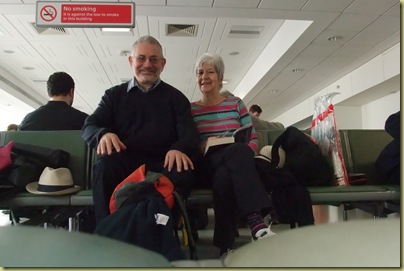The last time we went to Turkey was over 40 years ago when we were in our early twenties. We had announced to our parents that during our Universities’ summer holiday we were going to hitchhike around the Middle East (our budget was £1 per day each). The countries we intended to visit included Turkey, Iran, Iraq, Syria and Cyprus and if we had time, we would go as far as Pakistan. In the event we never got to Pakistan but we had a great time in Turkey and Iran, not so good a time in Iraq, crossed Syria on a train and went to Cyprus to stay with a University friend. We also travelled around a lot of Turkey, had a wonderful time and met lots of really nice people and very few other travellers but we never got to the western corner of Turkey.
This time we are visiting that missed corner by going on an archaeological exploration with Andante Travels (with whom we went to Pompeii and Herculaneum a couple of years ago). The intention is to go to some of the main sites in that corner of Turkey and learn as much as we can from the “Guide Lecturer” (as Prof William Manning is called) in the company of 10 other like minded people.
The official itinerary is:
Day One
Arrive Istanbul
Day Two
A day in Istanbul, including visits to major sites around the hippodrome and the Archaeological Museum.
Day Three
Long drive to catch ferry to Çannakale. South to visit the site of ancient Troy, evoking Homer’s epic poem and the endeavours of Heinrich Schliemann. At least nine cities have been identified here, one on top of the other, and a visit provokes much discussion about what went where!
Day Four
Assos, high on a rocky ridge, one of the most beautifully situated ancient sites in the world with a well preserved Doric temple to Athena, with views out over Lesbos.
Day Five
Pergamon, where the remains are spread over a wide area. The Aesclepion was famous as a healing centre, and pilgrims came from far and wide. The acropolis affords wonderful views, and the remains are spread all the way down the steep hillside. The theatre has one of the most precipitous inclines of any, with the famous altar of Zeus nearby (the sculptures, though, are in Berlin).
Day Six
Ephesus, one of the highlights of western Turkey. This was one of the richest cities in Asia Minor and continued to thrive through the Roman period, in spite of severe earthquake damage. One of the highlights is the Roman terraced houses, with painted walls and mosaics now beautifully restored. Reverence for Artemis of Ephesus continued throughout the city’s history, and her temple was one of the seven wonders of the ancient world. Above this stand the fortifications and basilica of St John at Selçuk, the city which replaced Ephesus in Medieval times. The excellent site museum is also at Selçuk.
Day Seven
Drive inland to Sardis, with its massive gymnasium. En route climb to the Hittite rock relief at Karabel.
Day Eight
Two little-visited ancient sites: Nysa, centre of learning and Alinda, in a very beautiful setting. Little has been excavated here, and not much is known of its early history, but its importance is reflected in some impressive remains, including a three-storeyed market.
Day Nine
Drive east up the valley of the Meander river, through some magnificent scenery to the spectacular site of Aphrodisias. The nearby mountains produced very fine white marble, and the city became famous for its sculptors.
Day Ten
Magical site of Priene, on a peaceful wooded hillside. The Temple of Athena, bouleterion, theatre and agora stand as very substantial ruins. Miletus, home of philosophers and scientists. Didyma,the huge temple, never completely finished, which housed an oracular shrine to Apollo.
Day Eleven
Temple of Zeus at Euromos; the mini- Mausoleum at Milas; and the deserted city at Stratonikeia, where the remains of the ancient city stand amongst traditional village houses which were abandoned after an earthquake in 1957.
Day Twelve
Bodrum (Halicarnassos), a Carian city, whose ruler, Mausolus, had such a magnificent tomb that its name became a generic one - the Mausoleum. Shipwreck Museum in the castle with its unique collection of material from the Bronze Age to the Middle Ages.
Day Thirteen
Fly home from Bodrum via Istanbul.
We are fully expecting the trip to be exhausting and that we will return educated and enlightened about a period of the Ancient World of which we know little about. Trip Advisor has good reports on all of the hotels we are scheduled to stay at, we know Turkish food can be very nice and we love Turkish Beer (EFES).
And so, an early Saturday morning finds us heading towards Heathrow on the (normally) 90 minute drive to a parking place outside of the Airport to catch a flight to Istanbul with Turkish Airlines. Having survived the closure of the M25 due to a traffic accident and after a good breakfast at the airport, we
are able to sit in the departure lounge, relieved to be here and looking forward to the coming days.

No comments:
Post a Comment